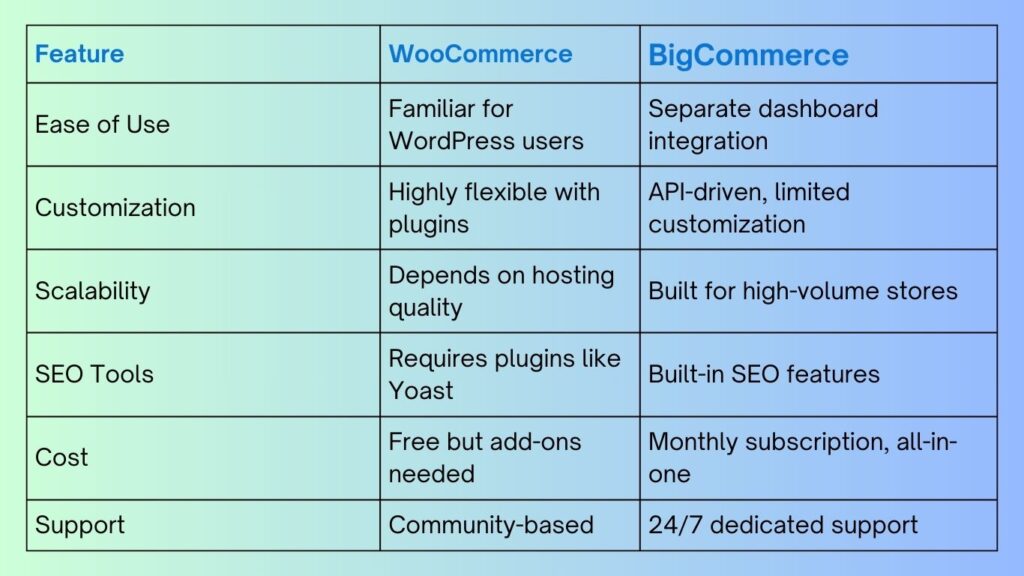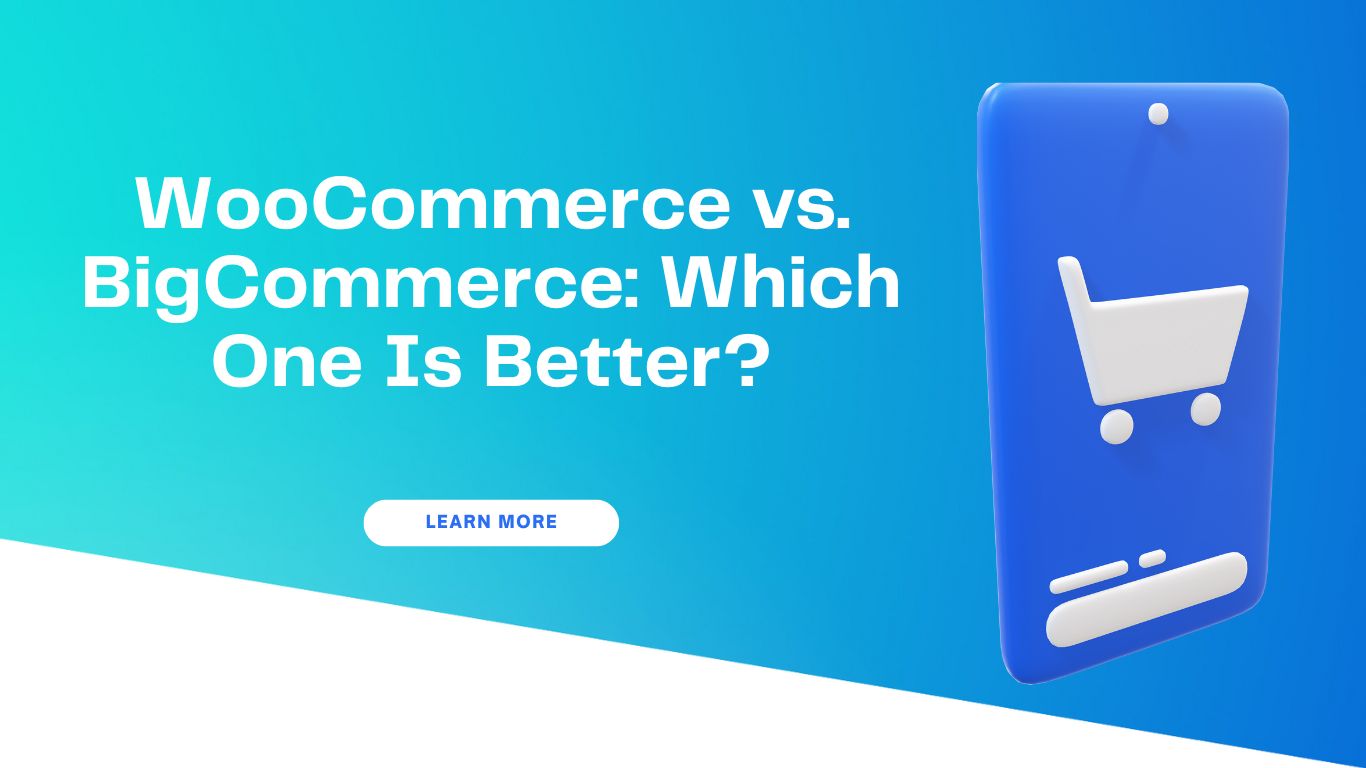Introduction
WooCommerce vs. BigCommerce Which one is the best to use for business? In the world of WordPress eCommerce, two plugins stand out: WooCommerce and BigCommerce. Each offers powerful features that enable businesses to run successful online stores on WordPress, but choosing the right solution depends on specific needs, budget, and long-term goals. This article dives into a side-by-side comparison of WooCommerce and BigCommerce for WordPress, helping you decide which platform aligns best with your eCommerce vision.
Overview of WooCommerce vs. BigCommerce
What Is WooCommerce?
WooCommerce is a widely-used open-source eCommerce plugin specifically designed for WordPress. It powers millions of online stores and offers endless customization options through themes and plugins. WooCommerce’s flexibility and large support community make it ideal for WordPress users who need total control over their online store’s design, features, and functionalities.
What Is BigCommerce?
BigCommerce is a leading eCommerce platform that now integrates seamlessly with WordPress. This approach allows users to combine the robust eCommerce functionality of BigCommerce with the design flexibility of WordPress. BigCommerce is known for its powerful, out-of-the-box features, high scalability, and ability to support large product catalogs, making it a solid choice for growing businesses.
Ease of Use
WooCommerce User Experience
WooCommerce fully integrates within the WordPress dashboard, making it familiar for WordPress users. Installation is straightforward, but setup can be time-consuming as you select themes, plugins, and customize your store. The learning curve is moderate; while customization options are extensive, they often require additional plugins or coding knowledge to get the exact look and functionality you want.
BigCommerce User Experience
BigCommerce offers a separate dashboard that’s linked to WordPress through an API integration. This “headless” approach lets you manage eCommerce features from BigCommerce while using WordPress for content. The setup is easy to follow with guided options, though it may feel less intuitive for WordPress-first users. However, BigCommerce’s streamlined approach means users benefit from fewer required plugins, resulting in a smoother experience for eCommerce newcomers.
Features Comparison for WooCommerce vs. BigCommerce
Product Management
- WooCommerce: Provides flexible product management, including categories, tags, attributes, and variations. It also allows for digital downloads, affiliate products, and grouped products, with extensive add-on plugins for advanced functionality.
- BigCommerce: Supports bulk product uploads, inventory management, and complex product configurations, suitable for large catalogs. BigCommerce also has a sophisticated inventory management system that seamlessly integrates with multi-channel retail platforms.
Payment Gateways and Fees
- WooCommerce: Compatible with popular payment gateways like PayPal, Stripe, and Square. Many additional gateways are available as plugins, but each may have different transaction fees and setup requirements.
- BigCommerce: Supports more than 65 payment gateways with zero transaction fees, regardless of plan. This setup can be an advantage for high-volume sellers, as BigCommerce offers competitive payment processing without extra costs.
SEO and Marketing Tools
- WooCommerce: Offers basic SEO features, enhanced by popular plugins like Yoast or All in One SEO. WooCommerce also supports various marketing tools, including email marketing plugins, product reviews, discount codes, and upselling options.
- BigCommerce: Provides built-in SEO features like optimized URLs, sitemaps, and customizable metadata fields. BigCommerce also offers email marketing integrations, advanced discount and coupon options, and analytics tools that help improve marketing strategies.
BigCommerce vs. WooCommerce: Which one is your Best Choice Book a free consultation
Performance and Scalability
Website Speed
- WooCommerce: Can slow down if too many plugins are used, especially with shared hosting. A dedicated WooCommerce hosting plan can improve speed and performance, but it’s essential to monitor and optimize to prevent delays.
- BigCommerce: Uses a headless commerce approach for WordPress, allowing faster load times by handling eCommerce processes separately from WordPress. This setup reduces plugin reliance and improves page speed, especially for high-traffic websites.
Handling High Traffic
- WooCommerce: Designed for scalability but relies heavily on hosting capabilities and optimization. High-traffic sites may require dedicated or cloud hosting solutions to manage load effectively.
- BigCommerce: Built to scale and handle large volumes of traffic with ease. BigCommerce’s infrastructure supports enterprise-level operations, making it a preferred choice for growing eCommerce sites with large inventories.
Design and Customization Options
Themes and Templates
- WooCommerce: Compatible with thousands of themes on the WordPress marketplace, including paid and free options. Most WordPress themes are WooCommerce-compatible, allowing you to tailor your store’s design to your branding.
- BigCommerce: Offers responsive themes that work well with WordPress. While the selection is smaller than WooCommerce’s, BigCommerce themes are well-suited for high-performance, optimized design.
Customization Flexibility
- WooCommerce: Offers unparalleled customization due to its open-source nature. Users can edit code, integrate custom plugins, and tweak CSS for tailored design. However, extensive customization may require coding knowledge or development support.
- BigCommerce: Allows API-driven customization, enabling developers to adjust the storefront while maintaining a secure, hosted eCommerce backend. This approach offers flexibility but can be limited compared to WooCommerce’s open-source customization.
Pricing Comparison for WooCommerce vs. BigCommerce
WooCommerce Costs
WooCommerce is free, but additional costs come from premium plugins, themes, and hosting. Expenses vary depending on the store’s needs, and custom functionalities can add up, making the final cost higher than expected for complex stores.
BigCommerce Costs
BigCommerce operates on a tiered pricing structure, starting at around $29/month for the Standard plan, with advanced features available in higher plans. Although pricier, BigCommerce’s plans include hosting, security, and scalability features, making it a predictable option for established businesses.
Security and Support of WooCommerce vs. BigCommerce
WooCommerce Security Measures
WooCommerce itself relies on WordPress security measures. It’s essential to use SSL certificates, install security plugins, and follow security best practices to safeguard data. WooCommerce stores are more susceptible to security vulnerabilities without proper configuration.
BigCommerce Security Features
BigCommerce provides PCI compliance, built-in SSL, and fraud protection, offering secure solutions out of the box. With dedicated support and routine updates, BigCommerce’s security measures reduce the risk of breaches, making it appealing for high-stakes eCommerce.
Customer Support Comparison
- WooCommerce: Primarily supported by a community forum, with additional paid support from hosting providers or third-party services.
- BigCommerce: Offers 24/7 support through chat, email, and phone. BigCommerce’s customer support is well-suited for business owners who want dedicated help available as they scale.
SEO Considerations for WooCommerce vs. BigCommerce
On-Page SEO
Both platforms enable customization for metadata, URLs, and images. WooCommerce relies on plugins like Yoast SEO, while BigCommerce has built-in SEO settings, making it slightly easier to manage for beginners.
URL Structure and Optimization
WooCommerce provides basic URL customization, while BigCommerce offers advanced control over URL slugs and SEO-friendly structures, potentially boosting search visibility.
Mobile-Friendliness and Speed
Both WooCommerce and BigCommerce offer mobile-responsive themes, but BigCommerce’s architecture provides an edge in page load speed, which directly impacts SEO.
Pros and Cons of WooCommerce and BigCommerce
WooCommerce Pros and Cons
Pros:
- Highly customizable and flexible.
- Wide selection of themes and plugins.
- Integrates seamlessly with WordPress.
Cons:
- Can become costly with added features.
- Performance issues without optimized hosting.
- Requires technical knowledge for customization.
BigCommerce Pros and Cons
Pros:
- Scalable, secure, and highly reliable.
- Streamlined setup with predictable pricing.
- Dedicated 24/7 support and advanced eCommerce features.
Cons:
- Higher upfront cost.
- Limited theme selection.
- Some customization limitations.
Which Platform is Best for Your Business from WooCommerce vs. BigCommerce?
Business Size and Requirements
- WooCommerce: Ideal for small to mid-sized businesses and those needing extensive customization. Great for those already comfortable with WordPress who want complete control over design.
- BigCommerce: Better suited for mid-to-large businesses that prioritize scalability and built-in security. It’s an ideal solution for high-traffic stores that need advanced eCommerce capabilities without managing multiple plugins.
Here’s a concise comparison table key differences between WooCommerce and BigCommerce for WordPress:

Conclusion and Recommendations
Ultimately, both WooCommerce and BigCommerce bring significant advantages to WordPress users, with WooCommerce offering flexible, cost-effective customization and BigCommerce providing a scalable, secure infrastructure for larger stores. By choosing the platform that aligns with your business goals, you can create an online store that’s optimized for growth and long-term success.
BigCommerce vs. WooCommerce: Which one is your Best Choice lets have a free consultation

